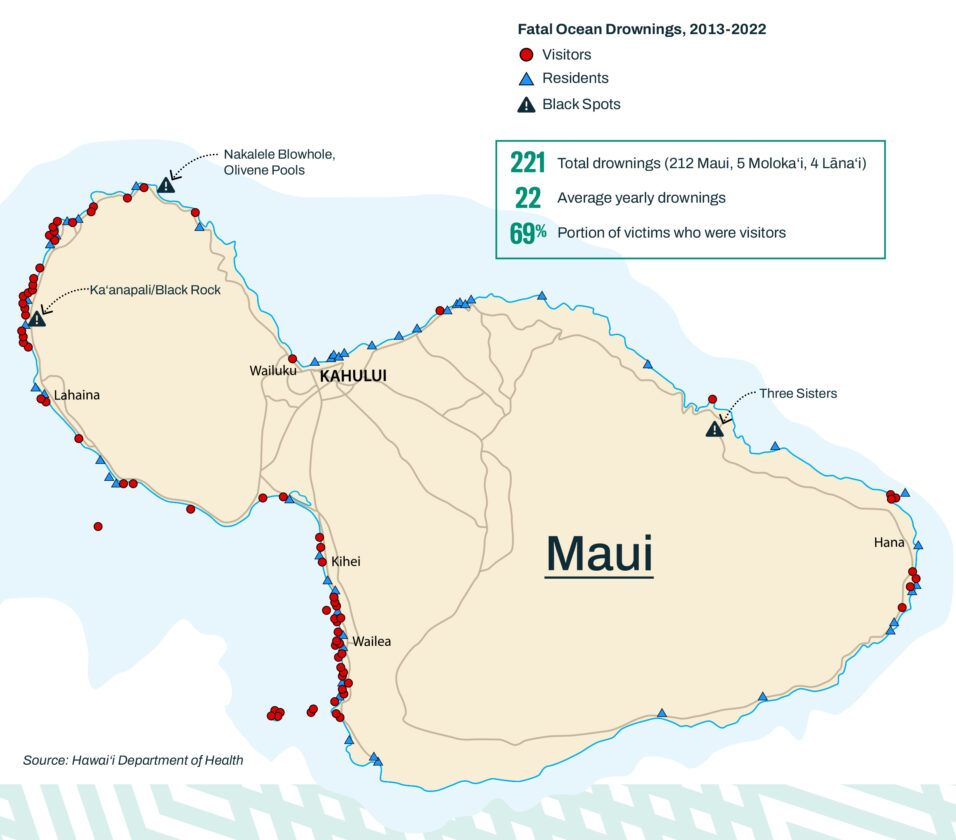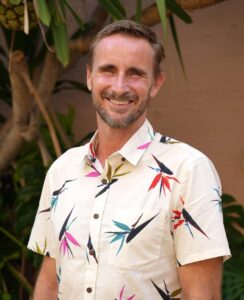County, groups look at ways to reduce drownings

Ocean Safety Bureau Chief Zach Edlao says a multi-pronged approach is needed to reduce the rate of drownings on Maui, as most of the deaths take place outside guarded county beaches.
He said the county uses jet skis to respond to rescue calls, including at resorts where visitors enjoy Maui’s beaches.
“They don’t see the beast. Everyone sees the ocean as something beautiful,” Edlao told Maui County Council members on Nov. 17.
They were meeting as the Water Authority, Social Services and Parks committee after an annual review by the state Department of Health found Maui has the highest rate of drownings among the Hawaiian islands.
Additionally, drownings were the No. 1 cause of fatalities among children ages 1 to 15 years old in Hawaii.
With 97 recorded drownings on the Valley Isle, Maui leads the state with the highest number of drownings per capita from 2020-24. The drowning rate for Maui was 45.1 per 100,000 population, compared to 41.6 for Kauai, 22 for the Big Island and 16.8 for Oahu.
Most of the ocean drownings on Maui took place outside of county beach parks, where there are no lifeguard towers. While less common, there are also some drownings in swimming pools included in the figures as well.
Edlao said visitor brochures provide ocean safety tips at stores, but the information only reaches those who are willing to read and follow the brochures.
Ocean Safety Operations Manager John Kaneshina said county lifeguards try to take preventative measures by warning visitors about potentially dangerous ocean situations when they can. He added that lifeguards on the beaches often use their PA system to give general warnings to beachgoers.
“They’re trying to prevent almost all the injuries,” he said.
The warnings can include strong winds that create bad snorkeling conditions, or high surf making a bad day for boogie boarding and bodysurfing.
He said the warnings make “a ton of difference. But at all our resorts, there’s no one doing that,” Kaneshina said.
Kaneshina said some visitors go snorkeling when the winds are high and they don’t know the ocean or how serious the consequences can be.
He said one way to reach the public is through the media and outreach programs, including visitor brochures, visiting schools, teaching students about safety and hazards in and around the ocean.
Edlao added that teaching youth to swim through various classes and programs offered locally makes a huge difference in preventing drownings.
“We need more ways to get the kids in the water to minimize this,” he said.
Edlao said the county has a successful Junior Lifeguard Program targeting children from 8 to 11 years old, but there’s more demand than they have space. He said there were 300 children participating in the Junior Lifeguard Program in the past year.
Kaneshina said the summer program is so popular it has had to turn away some children, and he hopes the program can be expanded.
More towers
In addition to knowledge and training, building lifeguard towers can also help prevent drownings, but it’s not as easy as some might think. One of the areas planned for a lifeguard tower is at Kaanapali Resort, which has been a hotspot for emergency ocean rescue calls.
Edlao said the bureau has faced challenges getting permits from the state to put up lifeguard towers at the location.
“All we’re waiting for is the permits,” he said. “The struggle for the permits is a big issue for us.”
In Hawaii, the state owns the coastline, and issues permits within it.
He said the county needs exemptions, perhaps with the governor’s help, to expedite the process of putting the lifeguard towers on the beaches.
Another hurdle in providing lifeguard service is the pay scale for Ocean Safety officers and the high cost of living on Maui, Edlao added.
He said Ocean Safety had eight positions available for new recruits starting in December, but the recruiting class had only four members.
In addition to struggling to fill open roles, he said some of the lifeguards are considering changing jobs for higher pay.
“It’s tough living here in Hawaii,” he said. “What can you do? They got to support their families.”
Swimming instruction helps
County pool manager Duke Sevilla said there’s been discussions with some schools such as Lokelani Intermediate to provide more swim classes, but he expects some pushback if others pool users see their classes canceled as a result of limited space.
“We all got to realize what’s important for the future is our kids,” Sevilla said about creating more opportunities for children to learn to swim.
Sevilla said pool managers might try new ways to reach people. For example, with so many divers on Maui, he suggested the county could consider providing a place where divers could train in more safe conditions, or people might take a snorkeling classes.
Sometimes the ocean is not the best place to learn on the fly, he said.
Support from the visitor industry
John Pele, executive director the Maui Hotel and Lodging Association, said some hotel employees have acted as lifeguards and they feel like it is their responsibility to keep people safe in the ocean.
But he added that helping with rescues or witnessing a drowning can take a serious emotional toll on them.
Pele said the commitment is there to improve water safety, and one of the ideas being discussed in Wailea is to perhaps enter into a public-private partnership to try to reduce the cost.
The committee deferred taking any action during the meeting, but Maui County Council Chair Alice Lee said the discussion was important and informative.
“I look forward to the next one,” Lee said.



